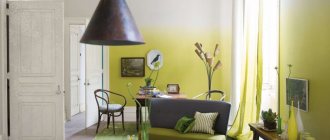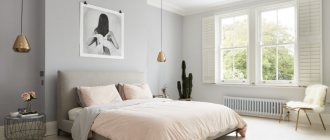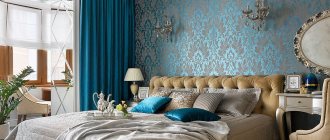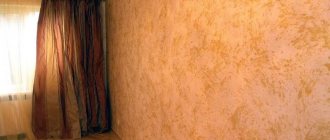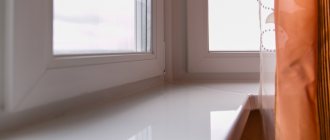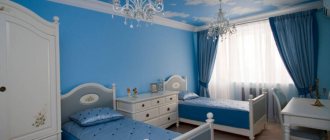When choosing a method of finishing walls, preference is increasingly given to painting. We wrote about the pros and cons of this method in the article “Guide to choosing wall coverings: wallpaper or painting?” Walls painted in the traditional way will be a suitable backdrop for both modern minimalism and vintage decor. However, when working with paint, you can get really creative by combining colors and shades. Some ways of combining paint will bring crazy pop art energy into the interior, while others will help create a harmonious background for a luxurious classic interior.
It is generally accepted that painted walls, unlike those covered with wallpaper, look dull and uninteresting. It's a delusion! Firstly, the paint can be tinted in absolutely any color. There is no such freedom with wallpaper: what the designers created is what you have to use. Secondly, the paint can be combined to achieve amazing effects. With wallpaper it is not always possible to achieve such interesting results.
Combining paint colors is not so easy. You will have to work very carefully. It is necessary to purchase a good masking tape that will not only protect the surface from paint, but will also be easily removed from it without pulling the finish layer with it. In addition, painting in two colors will require precision calculations, measurements and markings. You will also need patience, because some dyeing methods may take several days (step-by-step dyeing).
How to paint walls in two, three or four colors? There are several popular combination paint designs. When choosing, you need to take into account the style of the future interior, the features of the room layout, and, of course, personal preferences. So, let's look at the basic techniques for painting walls in several colors. But first, about some important nuances.
Combined wall painting: useful tips
A color scheme
There are three possible combinations:
- close or related colors: for example, two neutrals (black and white, gray and beige) or two cool pastels (blue and mint)
- “gradient”: tones of the same color of different saturation
- different colors: for example blue and red, green and orange
Having chosen the last color plan, try to choose shades that are similar in saturation, temperature and “sound”. If, for example, you take not orange, but peach, then instead of grass green it is better to use olive.
Designing a border between different colors
The border between two colors is not always perfectly neat and even. But this is not a problem: the joint can be decorated with polyurethane molding, paper border, wooden slats, plastic strips or, for example, borders made of stone, mosaic and pebbles - they just need to be glued to the joint line using liquid nails or other reliable glue.
Tinting with reserve
If you select shades not from a catalog, but guided by your own imagination, order paint tinting with a large margin. If the paint runs out and you have to tint a new portion, a complete match may not be achieved. It is especially important to create a reserve of paint if you are tinting it yourself.
Painting walls in two colors
Most often, 2 close shades or sharply contrasting colors are used. A two-color room is painted in different ways, creating both smooth color transitions and areas with clearly defined boundaries. If necessary, even in 2 shades it is easy to create ornamental patterns with geometric or smooth lines, complementing almost any interior style.
A limited selection of colors does not reduce the number of wall finishing options.
In modern and minimalist interiors, this method works more effectively than using more shades, while:
- the accent wall is complemented by decor to match the rest of the walls;
- stencils or ornamental painting look laconic and beautiful;
- a combination of stripes of 2 shades makes it possible to change the geometry of the room;
- in a studio room, even with two colors you can separate 2 zones, and in each of them you can make an accent with a second shade, without creating unnecessary diversity.
If the owner does not have enough brightness in the interior when using only 2 tones in painting the walls, it is easy to create a color spot in other details of the decor: textiles, furniture, etc.
Dividing walls horizontally
The part of the wall from the floor is painted with paint of one color, and above - with another. The boundary is usually drawn at about a third of the height from the floor. However, division can be done in another way. For example, exactly in half or with a predominance of the lower part. Sometimes the border runs almost under the ceiling.
Painting walls in two colors: traditional design
Dividing the wall below the midline is the traditional approach. This painting of walls in two colors is suitable for interiors in a variety of styles: classic, art deco, art nouveau, retro, country. When creating elegant modern interiors, this wall design is also justified. Painting with horizontal division creates an imitation of panels - the same ones that are mounted along the bottom of the wall. The border between two colors should be decorated with molding or decorative border.
Other options for dividing walls horizontally with offset color boundaries are usually used in children's rooms and in creative modern interiors.
How to paint? Here's one way. First you need to paint the entire wall a lighter shade. After the paint has dried, measure and draw a border line. Above or below the border, stick masking tape exactly along the drawn line. The tape is glued to the part that will no longer be painted. Next, paint the wall below or above the tape in a second color. In the first hour after painting, carefully remove the tape.
Advice from professionals
3 ways to combine colors.
- Colors of a close or related type or two pastel cold types.
- "Gradient". Tones of the same color with different saturation.
- Various colors.
The boundaries between the colors are drawn.
Wall painting options:
- dividing walls horizontally;
- the use of strips when decorating walls;
- gradient coloring;
- panel inserts;
- relief selection;
- creating correct geometric shapes;
- irregular lines with complex shapes;
- the effect of color on the dimensions of a room.
Painting walls in two colors is a popular type of decoration that creates a minimalist style. Combined coloring provides peace of mind and creates original interior solutions.
Color inserts
This is another method of painting with imitation panels. First, the wall is painted with paint of one color. After drying, future “panels” are marked. Masking tape is glued along these lines. The inside of the resulting squares or rectangles is painted over with a second color - usually darker, but a variety of solutions are possible. The tape is removed before the paint dries. Painted “panels”, as a rule, are framed with moldings, strips, and borders.
This wall decoration is ideal for classic, baroque and glamorous interiors. Wall decor is usually placed inside the “panels”: for example, clocks and sconces.
Wall decoration in the bedroom
In bedroom interiors, soft wall panels with textile and leather upholstery are used primarily to create a feeling of comfort and coziness. Also popular are inserts of designer wallpaper with a floral or thematic pattern, tapestry panels, relief gypsum panels and black glass in the decoration of the walls of the TV area.
Soft wall panels
view album in new window
Textile wall panels for bedside wall decoration
Soft wall panels for the bedroom are one of the striking characteristic features of designer interiors. They are designed by the author of the project and manufactured to order in furniture production. These functional interior design elements enhance the sound and heat insulation of bedrooms and do not require preliminary preparation of walls for installation, perfectly leveling any surface. Upholstery made of eco-friendly furniture velvet, satin or leather with dust- and dirt-repellent impregnation ensures ease of cleaning and long service life of soft wall decor.
Accent wall
This is a fashionable solution that allows you to make a bold statement in the interior without the risk of oversaturating it. Three walls in the room are painted in one color, usually neutral or quite light. The fourth is painted with a different color - it can be very discreet or very bright, depending on the desired effect.
Only part of the wall can be painted - for example, in the form of a wide vertical stripe. Read more about creating an accent wall in our article.
Design styles
Modern
The style uses single or two-tone wall painting, combining white with another color. The children's interior uses bright details in stripes and patterns on the wall. The emphasis is on practicality, so an unobtrusive palette and combinations are used.
Minimalism
Minimalism is observed in monochromatic painting, a combination of gray or pale blue with white, and decor with wide stripes. Sometimes contrasting molding or textured paint is used in the interior.
Loft
The interior is not limited to a specific color palette; the design is often used only on an accent wall. Brickwork can also be painted using ombre technology.
Classic
In the interior it is expressed in a neutral light background with golden, white monograms, in blue or black patterns, which are emphasized by tassels and fringe on velvet curtains of emerald or ruby color.
Provence
Provence or the French summer gloss of the interior is recognizable in pink, mint or blue walls, olive shade of curtains and textiles. The walls in the interior can be painted plain or striped. To create individuality, you can make an artistic painting on the wall in the form of an open window onto the summer Provencal fields.
The photo shows a turquoise bedroom in Provence style with monochromatic walls, classic furniture and floral textiles.
Country
The interior uses a combination of natural timber or stone with brown, mustard, white paint with a whitewash texture.
Scandinavian
The interior is as practical and light as possible, so the walls are creamy, white, or less often sandy or blue. Stripes, molding, 3D panels, and a white brick wall are suitable for decoration.
Painting walls as one of the types of finishing is used not only for external but also internal work thanks to paints that are odorless, dry quickly and do not harm health.
"Gradient"
This is a method of combined painting similar to the previous one, in which the entire surface of the wall has one color, different from the color of the other walls. But in this case, paint is used not of different colors, but of tones of the same color of different saturation. A sort of gradient is created. You can use 4 tones - a separate shade for each of the walls of the room.
Continuous horizontal stripe
This is a simple but very effective way to add variety to your wall design. First you need to paint them in one of the colors. After drying, mark two lines - the upper and lower boundaries of the future wide strip. Apply masking tape along these lines (outside the future strip). Now you need to apply the second color of paint inside the markings. Without waiting for it to dry, remove the tape.
This combination of painting walls in two colors is good for a corridor - a horizontal stripe visually reduces its height, making the room seem a little wider and more spacious. Wall decor is placed inside the strip - for example, small paintings or photo frames. In a children's room, the stripe can be decorated with stenciled designs.
Decorative plaster for wall decoration
view album in new window
Decorative concrete-look plaster for an accent wall in the living room
Speaking about wall decoration, it is worth knowing that such types of plaster as:
- cement-based mineral;
- acrylic (polymer);
- silicate (with a base on liquid potassium glass or silicone resin).
Decorative plasters
are considered:
- textured plaster for concrete;
- Venetian multilayer;
- Moroccan (glossy analogue of Venetian);
- Byzantine (subtype of Venetian);
- American (in the form of raindrops);
- liquid wallpaper (or Danish plaster);
- Munich plaster (acrylic with marble chips);
- silk plaster (pearl, thin layer).
Our designers at the Fundament Group of Companies competently select the types of decorative plaster taking into account the style of the interior and the type of room to make each project unique!
Textured concrete plaster in a modern interior with loft elements
view album in new window
Textured concrete plaster in the interior of a loft living room
Decorative textured concrete plaster is an ideal solution for interiors in loft, steampunk, industrial and grunge styles. It well imitates a rough concrete surface with chips, scratches and a web of cracks. This coating is an expensive type of wall finishing and requires special skill in application. But the effect in the form of a stunning, brutal and charismatic interior is worth it!
Venetian plaster combined with moldings, mirrors and marble panels
view album in new window
Venetian plaster and natural marble panels in the decoration of the hallway walls
With proper design, a laconic finish can become truly luxurious. Our designers create exclusive design projects for apartment interiors, in which long hallways and halls almost always devoid of natural light become attractive and stylish. Marble panels in combination with Venetian plaster and beveled mirrors, as well as modern ceiling lighting, create a magnificent play of textures, highlights and reflections.
view album in new window
Venetian plaster in the design of the walls of a living room in the Art Deco style with neoclassical elements
The same finishing material, framed by wall moldings with neoclassical stucco decoration, reveals its character in a new way. The interior of the living room, designed in beige monochrome, is especially interesting with the play of single-color textures. Muted beige velvet upholstery of upholstered furniture, light wood floors, wall panels and nude-colored furniture facades in combination with the shiny surface of the beige-gray “Venetian” delight the eye and touch with its textured variety.
Stripes on the walls
Using paint of two or three tones, you can turn a plain wall into a striped one. It is worth saying that this work is very painstaking, but the result is worth it.
Using two methods at once: dividing horizontally and painting with stripes
It’s easier to apply wide stripes: less fuss with tape, and not so many blots. In addition, wide stripes look softer and more unobtrusive.
Read more about the nuances associated with incorporating stripes into room design in our article “Striped walls in the interior: in the rhythm of color and size.” We wrote about how to make a wall striped in our other article: “Painting walls with stripes.”
Combined striped paint can be used not for all walls, but to create accent pieces. The strip can be either vertical or horizontal.
Beautiful examples in the interior
If you have chosen white or beige as the main, dominant color, then an excellent solution would be to combine it with blue, red, black, yellow, and pink tones.
The basic elegant black tone looks beautiful with white, green, and yellow.
Neutral gray combines well with yellow, green, white, beige and brown.
Traditional brown is combined with pink, white, green, yellow and beige.
The combination of aggressive bright red looks great with black, white, gray and yellow.
Cheerful orange combines well with chocolate, milk, and pistachio.
Noble yellow creates comfort with lilac, white, black, gray, brown.
Calming green goes well with purple, white, gray, black, yellow, and orange.
Light blue is combined with white, yellow, green.
Calming blue looks great with white, yellow, green, and beige.
The dominant purple is combined with beige, green, and gray.
To learn how to choose a color palette for the walls in the living room, watch the following video.
- home
- Home ideas
Painting walls in the interior makes the room not only attractive, but also creative with the help of a wide range of decorative techniques. Wall design ideas are not limited to plain painting; structural paint and other original decor options will create a beautiful interior.
Diamonds on the wall
This is a vintage solution, ideal for decorating a nursery, bedroom or kitchen in a retro style.
No less fuss, and probably even more, than with stripes. But the result is no less interesting, and most importantly, unusual: a wall painted in this way resembles an “old school” knitted vest. Thanks to this, the interior acquires a special warmth and naive charm.
Painting walls with diamonds will force some tinkering. First you need to paint the wall in the lighter of the selected colors. Then, when the paint has dried, mark out future diamonds. Decide what their alternation will be. Note which diamonds will be darker and which will remain light. Apply masking tape along the border of the diamonds that need to be painted a darker color (outside of the marking line). Paint the surfaces inside the markings and remove the tape. After the paint has completely dried, you can draw solid or dotted lines intersecting the sides of the diamonds. This will increase the similarity with the famous knitting pattern.
Niches, ledges, openings
Combined painting is designed to emphasize the geometry of such structures and place emphasis on them. Any recesses, niches, openings, as well as parts of the walls behind racks and shelves can be painted in a color different from the main color of the walls.
Complex shapes
Combined painting of walls allows you to introduce any, even the most bizarre, shapes into the interior. For example, the border of two colors can be arched, wavy, zigzag, etc. The second color can be superimposed on top of the first in large circles, ovals, triangles, etc.
Color lines can follow the shapes of furniture, decor and other interior details. This is an excellent solution for modern interiors and for rooms in a bright pop art style.
They usually paint without using tape. They simply mark the joint line, paint it a little with a roller, then carefully work with a brush, creating a clear, even border between the two colors.
Modern wall painting design
Today our topic is painting walls in the interior. We will talk about combining paints of different colors or shades. Using this technique, you can focus on the interior or its individual elements: niches, openings, shelving, etc. And it will look better than wallpaper with a finished pattern.
Having chosen the required color background, select shades that are similar in saturation, colorimetric temperature and “sound” - orange goes well with green, but olive is more suitable for peach.
Wall painting design: g radient
This is perhaps the simplest solution, since the entire surface is painted the same color. For this decoration, paint of the same color is used, but tones of different saturation: one for each wall.
Examples of wall painting: accent
This wall painting technique is suitable if you want to liven up your interior without the risk of oversaturating it. Three walls can be painted in one - unobtrusive, neutral color, and one can be painted in another - restrained or bright. Also, not the entire surface can be painted, but only part of it. Example in the photo.
Horizontal division of walls
When finishing with any materials, this design technique is used most often: one half should be painted in one color, and the second in another. Traditionally, the border is drawn below the midline, but there may be other solutions (above, in the middle, almost under the ceiling - example in the photo). We recommend painting the walls with any acrylic or silicone paint.
Painted walls in the interior.
To get a straight center line, you can use measuring tools and masking tape just in case.
The border between two colors is decorated with molding, decorative border (paper, mosaic, stone, etc.), wooden slats and other materials. In addition to their important decorative function, they will help hide streaks or unevenness in color at the border between two colors.
Stripes
For the bedroom and living room, two or three tones of one main color are often used. Contrasting colors are suitable for a children's room. Wider stripes are brighter and more noticeable; they are easier to draw. If you choose narrow stripes, keep in mind that from a more distant vantage point they may merge into one color and become invisible.
You can emphasize some stripes or make them voluminous with a metallic sheen or by creating a kind of “shadow” (using a darker color).
Water-based paint is also suitable for this option.
Stripes can be horizontal or vertical.
Photo of a surface painted with horizontal stripes.
Designers have this rule: the interior will look harmonious if you choose interesting accessories (curtains, decorative pillows, etc.) in the same color scheme as the walls (see photo). Now all this is very easy to find.
An interesting but controversial design decision is to paint the ceiling with the same stripes as the walls. A less intrusive option is to use strips of different sizes or colors for the ceiling.
A simpler but more effective modern way to add variety to your design is to draw one horizontal line.
Additionally, you can decorate the strip with the help of decor - photographs, paintings, in the nursery - with drawings made using a stencil.
Please note that a horizontal stripe will make the room visually wider and the ceilings will appear lower.
Scottish cell
Decorating with tartan in soft colors is similar to painting with stripes, but this requires greater precision in calculations and accuracy in painting. When painting with a tartan check, thick and thin stripes and lines alternate. First, the background is applied with a roller, then the ornament is marked with a laser level. Use masking tape to mark vertical stripes and paint them in a different color or tone from the background. The same stripes are made horizontally.
Due to the overlap of threads, the intersections of stripes on the fabric appear darker. Since we paint the wall a different color after the previous coat of paint has dried, the same effect can be achieved by using a darker shade and painting with it.
To avoid having to repaint, a protective varnish is applied at the very end - it will protect the decor from moisture and other external influences.
Raskarska in patchwork style
You can imitate the patchwork technique by painting the wall with large squares. The recommended size is about 30 cm. Mark the surface of the wall or partition using a pencil and ruler, and then paint, having thought through the drawing well. It is better if you first draw it on a piece of paper. Bedspreads, furniture covers, tablecloths and other designer items using the patchwork technique will add a special chic to the room.
Diamonds
Walls decorated with diamonds imitate a knitted vest with a once popular pattern and are suitable for a room decorated in a retro style. This pattern will add some naivety and homely warmth to any modern interior.
Color inserts
This painting method imitates the use of decorative panels. The wall is first decorated with one color, and after drying, paint of a different color is applied in the form of rectangular or other shaped panels. Curbs, strips, and moldings are often attached to the edges of the “panels.” Inside the “panels” there is wall decor (lamps, paintings, clocks).
Painting with polka dots
Polka dots are also used to create a retro style. Drawing such a pattern is not difficult: first, the wall is painted in the background color (but preferably not white), and then circles are drawn using a stencil - randomly or systematically located. Templates can be made independently or downloaded on the Internet.
old lock
Techniques that imitate ancient stone walls are not easy. Therefore, it is better to try it on a large sheet of cardboard. You will need 3-4 shades of matte paint with a grainy texture (1-2 neutrals and a couple of colors). First, draw all the blocks of one tone (color), then - other tones.
The paint is applied with a small roller, and then, while it is still wet, removed with light pressure from a sponge or rag. In some areas you can add individual strokes (veins in the stones) with a thin brush. It will be difficult to repaint, you need to be more careful.
Complex shapes
Using several colors, you can create fancy shapes. Make the border between two colors not even, but wavy or zigzag, put the second color on top of the first in the form of triangles and ovals, and you will create an original modern interior! This type of painting is done without tape: mark the joint lines, paint, do not finish them with a roller, then carefully paint with a brush.
painting
Before painting, think carefully about the design. First it is applied with a pencil. The final result depends on your wishes and imagination.
Stencils will make painting easier. You can buy a ready-made one or make it yourself by creating a drawing in a graphics editor or downloading the image you like from the Internet and printing it on a special printing film. The choice is yours.
Textured painting
You can make the color scheme more interesting and varied by using a combination of textured surfaces. This technique has another advantage - it will help hide all defects, and therefore you can prepare the surface for painting less carefully.
A textured surface can be created using paints with special fillers (sawdust, quartz sand, etc.). To create a “velvet” surface (voluminous and rough), add a small amount of thickener or plasticizer to the paint.
Different surface textures can be created using the simplest “tools”: a sponge, a crumpled piece of rags, film, a small broom. A regular or notched trowel, a long-nap roller, etc. are often used. You can also purchase special patterned rollers.
Even if you don’t have any of the above on hand for registration, it doesn’t matter! This should not stop a true creator! After all, you can decorate the surface in an original way with your fingers. This option is suitable for a cozy kitchen, a bright living room, and other rooms in an apartment or house.
Combine, experiment, and you will achieve amazing effects!
From our video on FORUMHOUSE.RU you can learn more about the ideal decorative painting of walls.
Polka dot walls
This idea is usually embodied in children's rooms. Although polka dots are also appropriate in living rooms, bedrooms, and kitchens, if we are talking about styles such as country and retro. Painting walls with polka dots is easy: first you need to paint the walls with a lighter paint, then using a stencil, using a brush or sponge, apply another color or several other colors in the form of randomly or systematically located circles.

